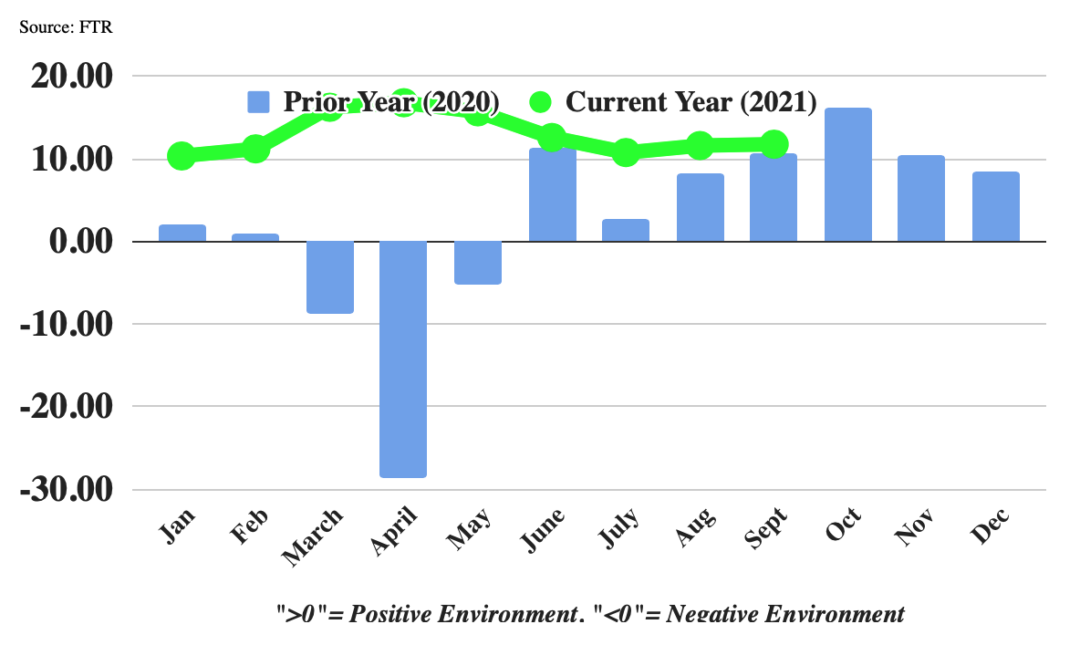FTR: trucking fleets will enjoy a strong market “well into 2022”
Consumer spending stays strong despite worries over inflation and supply chain woes, but retailers wary of challenges in the new year, NRF and Aptos say.

Business conditions for trucking fleets is forecast to remain strong “well into 2022” after an economic gauge of freight markets ticked up slightly in September, according to the supply chain analysis firm FTR.
FTR’s Trucking Conditions Index (TCI) reading for September increased marginally to 11.79 from 11.63 in August, as freight rates continued to strengthen although freight volume and capacity utilization were not as beneficial to carriers as they were in July and August, the Bloomington, Indiana-based firm said.
According to FTR, its TCI tracks changes in five U.S. trucking conditions: freight volumes, freight rates, fleet capacity, fuel price, and financing. Combined into a single index, the number represents good conditions when positive, poor conditions when negative, and a forecast for “significant operating changes” when it reaches double digits either way.
“The market remains stubbornly favorable to carriers due in large part to continued strong consumer spending and the effects of supply chain troubles on productivity,” Avery Vise, FTR’s vice president of trucking, said in a release. “The latest payroll employment data for trucking implies a considerably stronger recovery in driver capacity than had appeared previously, but the ongoing surge in newly authorized small carriers continues to shift capacity and thwart a return to normal.”
Looking into future months, Vise said several challenges remain. “Even if carriers start to see recruiting challenges ease up, continued struggles in truck production due to parts and material shortages could limit capacity in the months ahead. A key factor for the freight market will be whether consumer spending remains so robust beyond the holidays and the end of advance child tax credit payments in December,” he said.
And indeed, recent shopping statistics show that consumer spending is on track to stay strong. The National Retail Federation said today that retail sales rose in October as many consumers began holiday shopping early to avoid any shortages amid pandemic-driven supply chain disruptions that are dominating businesses and shoppers this holiday season.
“Despite significant challenges including supply chain issues, labor shortages, rising inflation, and OSHA’s impending employer vaccine mandate, retailers are continuing to safely serve consumers online and in stores,” NRF President and CEO Matthew Shay said in a release. “Today’s numbers show that consumers are getting a jump on their holiday shopping. We continue to urge consumers to shop early and shop safely, and we fully expect this holiday season to be one for the record books.”
NRF’s calculation of retail sales – which excludes automobile dealers, gasoline stations and restaurants to focus on core retail – showed October was up 1.7% seasonally adjusted from September and up 10.8% unadjusted year-over-year. That compared with increases of 0.4% month-over-month and 10.9% year-over-year in September.
Consumer confidence and buying power are running high despite recent inflationary trends, but retailers are watching closely to see if that trend expires in the new year, according to Dave Bruno, director of retail market insights at Aptos, a retail technology company.
“The big question, obviously, is whether much of the planned holiday buying is being done early and December sales will suffer, or if this confidence and buying power will sustain strong growth throughout the entire season,” Bruno said in a statement.
“Retailers will need to be very strategic with their messaging, promotions, and offers if they hope to reduce the risk of a late-season slowdown,” he said. “Carefully timed and targeted offers must be combined with incentives and discounts on alternatives to out-of-stock items and flexible omnichannel strategies that evolve as Covid case counts fluctuate. This will give retailers the best chance to sustain strong growth into the new year."
October retail sales grew as consumers got an early start on #holiday shopping. https://t.co/bnJTFdfIP9 pic.twitter.com/pmrNuMTZd1
— National Retail Federation (@NRFnews) November 16, 2021
Related Articles

Copyright ©2024. All Rights ReservedDesign, CMS, Hosting & Web Development :: ePublishing